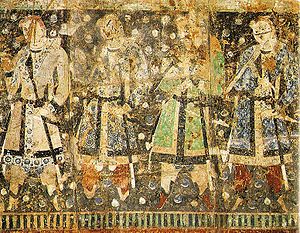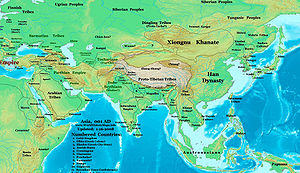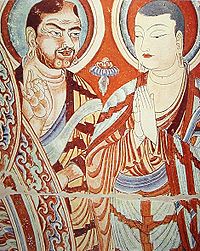Tocharians
| Total population | |||
|---|---|---|---|
| Extinct. Possibly among the ancestors of the Tajiks, Pashtuns, and/or Uighurs | |||
| Regions with significant populations | |||
|
|||
| Languages | |||
| Religion | |||
|
Buddhism and Manicheism |
|||
| Related ethnic groups | |||
|
Other Indo-European peoples, other Indo-Iranian peoples, Yuezhi, Kushans, genes found in Tarim mummies supports evidence of relations between the DNA found in western Eurasia (in or around Ukraine), South Asians(desi) and East Asians. |
|
Indo-European topics |
|---|
| Indo-European languages (list) |
| Albanian · Armenian · Baltic Celtic · Germanic · Greek Indo-Iranian (Indo-Aryan, Iranian) Italic · Slavic extinct: Anatolian · Paleo-Balkan (Dacian, |
| Proto-Indo-European language |
| Vocabulary · Phonology · Sound laws · Ablaut · Root · Noun · Verb |
| Indo-European language-speaking peoples |
| Europe: Balts · Slavs · Albanians · Italics · Celts · Germanic peoples · Greeks · Paleo-Balkans (Illyrians · Thracians · Dacians) ·
Asia: Anatolians (Hittites, Luwians) · Armenians · Indo-Iranians (Iranians · Indo-Aryans) · Tocharians |
| Proto-Indo-Europeans |
| Homeland · Society · Religion |
| Indo-European studies |
The Tocharians were the Tocharian-speaking inhabitants of the Tarim Basin, making them the easternmost speakers of Indo-European languages in antiquity.
Contents |
Name
The term Tocharian or Tokharian has a complex history. It is based on the ethnonym Tokharoi (Greek Τόχαροι) used by Greek historians (e.g. Ptolemy VI, 11, 6). The first Greek mention of the Tocharians appeared in the 1st century BC, when Strabo presented them as a Scythian tribe, and explained that the Tocharians — together with the Assianis, Passianis and Sakaraulis — took part in the destruction of the Greco-Bactrian kingdom (present day Afghanistan-Pakistan) in the second half of the 2nd century BC.[1]
These Tocharians have frequently been identified with the Yuezhi and the later (and probably related) Kushan peoples. Many scholars believe the Yuezhi originally spoke a Tocharian language. However, the debate about the origins and original language(s) of the Yuezhi and the Kushan continues, and there is no general consensus.[2] The geographical term Tokharistan usually refers to 1st millennium Bactria (Chinese Daxia 大夏).
Today, the term is associated with those Indo-European languages known as "Tocharian". Tocharian A is also known as East Tocharian, or Turfanian (of the city of Turpan), and Tocharian B is also known as West Tocharian, or Kuchean (of the city of Kucha)
Based on a Turkic reference to Tocharian A as twqry, these languages were associated with the Kushan ruling class, but the exact relation of the speakers of these languages and the Kushan Tokharoi is uncertain, and some consider "Tocharian languages" a misnomer. The term is so widely used, however, that this question is somewhat academic. Tocharians in the modern sense are, then, defined as the speakers of the Tocharian languages. These were originally nomads, and lived in today's Xinjiang (Tarim basin).
The native name of the historical Tocharians of the 6th to 8th centuries was, according to J. P. Mallory, possibly kuśiññe "Kuchean" (Tocharian B), "of the kingdom of Kucha and Agni", and ārśi (Tocharian A); one of the Tocharian A texts has ārśi-käntwā, "In the tongue of Arsi" (ārśi is probably cognate to argenteus, i.e. "shining, brilliant"). According to Douglas Q. Adams, the Tocharians may have called themselves ākñi, meaning "borderers, marchers".
Archaeology

The Tarim mummies suggest that precursors of these easternmost speakers of an Indo-European language may have lived in the region of the Tarim Basin from around 1800 BC until finally being assimilated by Uyghur Turks in the 9th century AD. This is evidenced by both the mummies[3] and Chinese writings.[4]
A later group of Tocharians were the Kushans and maybe some Iranian tribes of the Hephthalites whose Iranian population also settled in modern Afghanistan, North-Eastern Iran, Uzbekistan, Tajikistan and Turkestan, whereas the nomadic Turkic tribes were defeated by Bahram Gur and the Gokturks, who pushed them over the Hindukush mountains to Sindh (Pakistan) and North-West India.
The Tarim Basin mummies (1800 BC) and the Tocharian texts and frescoes from the Tarim Basin (AD 800) have been found in the same general geographical area, and are both connected to an Indo-European origin. The mummies and the frescoes both point to White types with light eyes and hair color. However it is unknown if the frescos and mummies are directly connected.
Mallory & Mair (2000:294–296, 314–318) argue that the Tocharian languages were introduced to the Tarim and Turpan basins from the Afanasevo culture to their immediate north. The Afanasevo culture (c. 3500–2500 BC) displays cultural and genetic connections with the Indo-European-associated cultures of the European steppe yet predates the specifically Indo-Iranian-associated Andronovo culture (c. 2000–900 BC) enough to isolate the Tocharian languages from Indo-Iranian linguistic innovations like satemization.[5]:260, 294–296, 314–318
In 2008, the remains of another male were discovered near Turpan, China. Thought by researchers to be a member of the Gushi culture, the man was buried with a number of practical and ceremonial objects, including archery equipment and a harp, and 789 grams of marijuana. Through genetic analysis and carbon dating, the burial has been dated to roughly 700 B.C. Only two of the 500 graves at the site contain marijuana, leading researchers to suggest shamanic roles for the two individuals.
In 2009, the remains of individuals found at a site in Xiaohe were analyzed for Y-DNA and mtDNA markers. They suggest that an admixed population of both west and east origin lived in the Tarim basin since the early Bronze Age. The maternal lineages were predominantly East Asian haplogroup C with smaller numbers of H and K, while the paternal lines were all West Eurasian R1a1a. The geographic location of where this admixing took place is unknown, although south Siberia is likely.[6]
Language
The Tocharians appear to have originally spoken two distinct languages of the Indo-European Tocharian family, an Eastern ("A") form and a Western ("B") form. According to some, only the Eastern ("A") form can be properly called "Tocharian", as the native name for the Western form is referred to as Kuchean (see below). Commonalities between the Tocharian languages and various other Indo-European language families (as with Celtic, Germanic, Balto-Slavic, even Italic or Greek) have been suggested, but the evidence does not support any close relationship with any other family. The only consensus is that Tocharian was already far enough removed, at an early date, from the other eastern Indo-European proto-languages (Proto-Balto-Slavic and Proto-Indo-Iranian), not to share some of the common changes that PBS and PII share, such as early palatalization of velars.
Tocharian A of the eastern regions seems to have declined in use as a popular language or mother tongue faster than did Tocharian B of the west. Tocharian A speakers probably yielded their original language to Turkic languages of immigrating Turkic peoples, while Tocharian B speakers were more insulated from outside linguistic influences. It appears that Tocharian A ultimately became a liturgical language, no longer a living one, at the same time that Tocharian B was still widely spoken in daily life. Among the monasteries of the lands inhabited by Tocharian B speakers, Tocharian A seems to have been used in ritual alongside the Tocharian B of daily life.
Besides the religious Tocharian texts, the texts include monastery correspondence and accounts, commercial documents, caravan permits, medical and magical texts, and a love poem. Their manuscript fragments, of the 8th centuries, suggest that they were no longer either nomadic or "barbarian (hu)" as the Chinese had considered them.
Historic role


The Tocharians, living along the Silk Road, had contacts with the Chinese, Persians, Indian and Turkic tribes. They might be the same as, or were related to, the Indo-European Yuezhi who fled from their settlements in the eastern Tarim Basin after attacks by the Xiongnu in the 2nd century BC (Shiji Chinese historical Chronicles, Chap. 123) and expanded south to Bactria and northern India to form the Kushan Empire.
The Tocharians who remained in the Tarim Basin adopted Buddhism, which, like their alphabet, came from northern India in the first century of the 1st millennium, through the proselytism of Kushan monks. The Kushans and the Tocharians seem to have played a part in the Silk Road transmission of Buddhism to China. Many apparently also practised some variant of Manichaeanism.
Protected by the Taklamakan Desert from steppe nomads, the Tocharian culture survived past the 7th century.
In Sanskrit literature
Sanskrit literature in numerous instances refers to the Tocharians as Tukhāra (also Tuṣāra, Tuḥkhāra, Tukkhāra).
The Atharavaveda-Parishishta[7] associates them with the Sakas, Greeks and Bactrians.[8] It also juxtaposes the Kambojas with the Bactrians.[9] This shows they probably were neighbors in the Transoxian region. The Rishikas are said to be same people as the Yuezhi.[10] The Kushanas or Kanishkas are also the same people.[11]
M. A. Stein proposed that the Tukharas were the same as the Yuezhi.[12] P. C. Bagchi holds that the Yuezhi, Tocharioi and Tushara were identical.[13].
The Parama Kambojas of the Trans-Pamirs, mentioned in the Mahabharata are said to be related to the Rishikas [14] who are placed in Sakadvipa (or Scythia).[15] B. N. Puri takes the Kambojas to be a branch of the Tukharas.[16] Some scholars state that the Kambojas were a branch of the Yuezhi.[17]
Sabha Parva of Mahabharata states that the Parama Kambojas, Lohas and the Rishikas were allied tribes.[18] Like the "Parama Kambojas" ("most distant Kambojas"), the Rishikas of the Transoxian region are similarly styled as "most distant" or "Parama Rishikas"[19]. Based on the syntactical construction of the Mahabharata verses 5.5.15 and 2.27.25, Ishwa Mishra believes [20] that the Rishikas were a section of the Kambojas, i.e. Parama Kambojas.
See also
- Tocharian languages
- Tarim mummies
- Kizil Caves
- Bezeklik Thousand Buddha Caves
- Kucha
- 突厥 Tūjué
- Hephthalite
- Kushan Empire
- Sogdiana
- Yuezhi
- Rishikas
- Parama Kambojas
References
- ↑ "Most of the Scythians, beginning from the Caspian Sea, are called Scythian Daheans, and those situated more towards the east Massageteans and Saceans; the rest have the common appellation of Scythians, but each separate tribe has its peculiar name. All, or the greatest part of them, are nomads. The best known tribes are those who deprived the Greeks of Bactriana, the Asians, Pasians, Tocharians, and Sacarauls, who came from the country on the other side of the Jaxartes, opposite the Sacean and Sogdians."; (Strabo, 11-8-1)
- ↑ Through the Jade Gate to Rome: A Study of the Silk Routes during the Later Han Dynasty, 1st to 2nd Centuries CE, pp. 310-312. (2009). John E. Hill. BookSurge, Charleston, South Carolina. ISBN 978-1-4392-2134-1.
- ↑ "The Takla Makan Mummies". PBS. http://www.pbs.org/wgbh/nova/chinamum/taklamakan.html. Retrieved 17 January 2008.
- ↑ Xuanzang is said to have reported upon this The Oases of the Northern Tarim Basin at http://depts.washington.edu
- ↑ Mallory & Mair (2000)
- ↑ Li, Chunxiang. "Evidence that a West-East admixed population lived in the Tarim Basin as early as the early Bronze Age". BMC Biology. http://www.biomedcentral.com/1741-7007/8/15#IDAH0OBH. Retrieved 17 February 2010.
- ↑ Ed Bolling & Negelein, 41.3.3
- ↑ Saka. Yavana.Tushara.Bahlikashcha.
- ↑ Kamboja-Bahlika......AV-Par, 57.2.5; cf Persica-9, 1980, p 106, Michael Witzel.
- ↑ (India as Known to Panini, p 64, V. S. Aggarwala, V. S. Aggarwala.
- ↑ Bhartya Itihaas ki Ruprekha, 1941, J. C. Vidyalnkara
- ↑ Rajatarangini of Kalhana, I, p 6, trans. M. A. Stein (1900).
- ↑ India and Central Asia, 1955, p 24.
- ↑ The Deeds of Harsha: Being a Cultural Study of Bāṇa's Harshacharita, 1969, p 199, Vasudeva Sharana Agrawala.
- ↑ India as Known to Pāṇini: A Study of the Cultural Material in the Ashṭādhyāyī, 1953, p 64, Vasudeva Sharana Agrawala - India; A Grammatical Dictionary of Sanskrit (Vedic): 700 Complete Reviews of the ..., 1953, p 62, Vasudeva Sharana Agrawala, Surya Kanta, Jacob Wackernagel, Arthur Anthony Macdonell, Peggy Melcher - India.
- ↑ Puri, B. N. Buddhism in Central Asia, p. 90.
- ↑ Journal of Tamil Studies, 1969, pp. 86, 87, International Institute of Tamil Studies - Tamil philology.
- ↑ Mahabharata 2.26.25: See: trans. by Kisari Mohan Ganguli [1].
- ↑ Mahabharata 2.26.26.
- ↑ See: Indiancivilization Forum, messages No 64552 dated Sept 27, 2004; Message 64654, dated September 29, 2004 , Adhin88 (alias Ishwa Misra); Jathistory Forum, Message 454, Dated April 15, 2003, Ishwa Misra.
Books and magazines
Note: Recent discoveries have rendered obsolete some of René Grousset's classic The Empire of the Steppes: A History of Central Asia, published in 1939, which, however, still provides a broad background against which to assess more modern detailed studies.
- Baldi, Philip. 1983. An Introduction to the Indo-European Languages. Carbondale. Southern Illinois University Press.
- Barber, Elizabeth Wayland. 1999. The Mummies of Ürümchi. London. Pan Books.
- Beekes, Robert. 1995. Comparative Indo-European Linguistics: An Introduction. Philadelphia. John Benjamins.
- Hemphill, Brian E. and J.P. Mallory. 2004. "Horse-mounted invaders from the Russo-Kazakh steppe or agricultural colonists from Western Central Asia? A craniometric investigation of the Bronze Age settlement of Xinjiang" in American Journal of Physical Anthropology vol. 125 pp 199ff.
- Lane, George S. 1966. "On the Interrelationship of the Tocharian Dialects," in Ancient Indo-European Dialects, eds. Henrik Birnbaum and Jaan Puhvel. Berkeley. University of California Press.
- Mallory, J. P.; Mair, Victor H. (2000). The Tarim Mummies: Ancient China and the Mystery of the Earliest Peoples from the West. London: Thames & Hudson.
- Walter, Mariko Namba 1998 Tocharian Buddhism in Kucha: Buddhism of Indo-European Centum Speakers in Chinese Turkestan before the 10th Century C.E. Sino-Platonic Papers No. 85. October, 1998.
- Xu, Wenkan 1995 "The Discovery of the Xinjiang Mummies and Studies of the Origin of the Tocharians" The Journal of Indo-European Studies, Vol. 23, Number 3 & 4, Fall/Winter 1995, pp. 357-369.
- Xu, Wenkan 1996 "The Tokharians and Buddhism" In: Studies in Central and East Asian Religions 9, pp. 1-17.[2]
- Zuev, Ü.A. 2002, Early Türks: Outline of history and ideology, Almaty, "Daik-Press" ISBN 9985-441-52-9 (In Russian)
External links
- Tocharian alphabet.
- Tocharian alphabet
- Modern studies are developing a Tocharian dictionary.
- Mark Dickens, 'Everything you always wanted to know about Tocharian'.
- Mysterious Mummies of China by Nova on Google Video
- “The Dead Tell A Tale China Doesn’t Care to Listen To” New York Times November 19, 2008—Has closeup picture of one of the Tarim mummies known as the “Loulan Beauty”:
- Downloadable article: "Evidence that a West-East admixed population lived in the Tarim Basin as early as the early Bronze Age" Li et al. BMC Biology 2010, 8:15. [3]